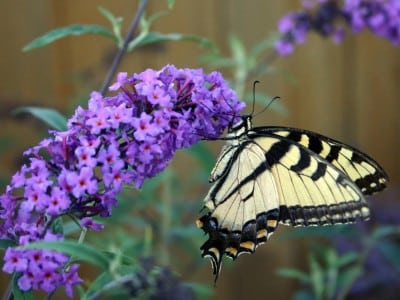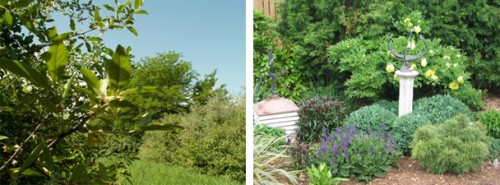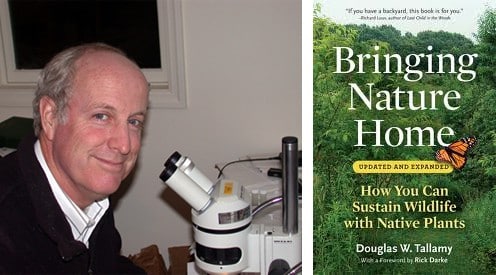By Julie Moir Messervy
Professor Doug Tallamy’s vital message to the gardening and horticulture community: How we garden can help determine whether most of our native species will avoid extinction.
What looks like uncultivated wilderness may in fact be a thicket of autumn olive, Oriental bittersweet, or Japanese honeysuckle—all exotic invasives that do not sustain our native insects and birds. Unfortunately, the lovely garden we plant in its place, if we do not take care to include native plants, may also do nothing to sustain wildlife. L: Autumn olive. Photo: U.S. Army Corps of Engineers. R: A carefully planned perennial bed. Photo: University of Illinois Extension.
L: Doug Tallamy. Photo: University of Delaware. R: Doug’s book, Bringing Nature Home. Photo: Amazon.
I just returned from giving my “Home Outside” lecture at the Middleburg Horticulture Symposium, hosted by the Fauquier and Loudoun Garden Club on Saturday, February 26 in Middleburg, Virginia. A superbly organized program, the event began with one of the best lecturers I’ve ever heard, and believe me, I’ve heard just about everyone in the field over my thirty-plus years on the circuit. Behavioral Ecologist Doug Tallamy of the University of Delaware spoke for a spellbinding hour and a half about how our headlong rush to develop nature has resulted in sterilized environments that are killing the biodiversity that insects, birds, and animals all need to survive in our world. Everyone should hear him speak if they can. His talk was a “game changer” for me, fundamentally altering the way I now think about what I should be doing as a landscape designer.
In both his lecture and his groundbreaking book, Bringing Nature Home (Portland, OR: Timber Press, 2007), Doug lays out the most compelling case I’ve heard yet for using native plants in our landscapes to help replace the loss of our temperate forests. (It has been estimated that over 70% of the forests along the Eastern seaboard are gone, versus only 15% of the Amazonian basin—why, he asks, aren’t we upset about what’s happening in our own backyard?) And not only are we cutting down our forests, but we’re also filling up our backyards with alien grasses—our lawns—and exotic plants from other countries. Yet research shows that our native insects cannot survive on alien plant species. He quotes eminent biologist E.O. Wilson who said, “A land without insects is a land without most forms of higher life.” Ultimately, this includes us.
Many gardeners plant buddleia, or butterfly bush, to attract butterflies to their gardens…but did you know that these shrubs feed only the adult butterflies? Their larvae feed on the leaves of native plants, such as wild black cherry, goldenrod, and milkweed. Photo: TheButterflySite.com.
In the introduction to his book, Doug succinctly explains the problem of filling our backyards with lawns and exotic plants as we do now:
- “…the wild creatures we enjoy and would like to have in our lives will not be here in the future if we take away their food and the places they live.
- “…in too many areas of our country there is no place left for wildlife but in the landscapes and gardens we ourselves create.”
- “…unless we restore native plants to our suburban ecosystems, the future of biodiversity in the United States is dim.”
Yet all is not lost, he writes, if we can make changes to the way we design our properties and open spaces:
- “…it is not yet too late to save most of the plants and animals that sustain the ecosystems on which we ourselves depend.
- “…restoring native plants to most human-dominated landscapes is relatively easy to do.”
In his talk, Doug showed images of how a suburban property and its neighborhood might bring back biodiversity by planting the boundaries with native shrubs and trees. If whole communities started planting this way, we’d create a shared woodland where the collection of plants and animals could live in relative balance.
L: Typical suburban home and landscape. C: The same home, with a landscape enhanced by the addition of diverse native plantings. R: In Tallamy’s vision, a suburban neighborhood full of such landscapes forms a corridor of wildlife-sustaining flora that can co-exist with human habitations. Perspectives by Jana Bryan Wunderle of JMMDS, based on Doug Tallamy’s drawings.
He exhorts us all to do something that most of us only dream of doing: make a difference. “In this case,” he writes, “the ‘difference’ will be to the future of biodiversity, to the native plants and animals of North America and the ecosystems that sustain them.” Let’s get going!
Click here to read Anne Raver’s 2008 New York Times article, which contains more eye-opening details about Doug’s work.
Julie’s Upcoming Lectures
The following events are open to the public:
“Home Outside: Creating the Landscape You Love.” 2011 Vermont Flower Show keynote address. Champlain Exposition Center, Essex Junction, VT. Saturday, March 5, at 12 p.m.
“Home Outside: Creating the Landscape You Love.” Virginia Crigler Speaker Series hosted by the Carolina Foothills Garden Club at the Poinsett Club, Greenville, SC. Wednesday, March 16, at 10:30 a.m.
“Julie Moir Messery: Process and Work.” Lewis Ginter Botanical Garden, Richmond, VA. Wednesday, April 27 at 5 p.m.










I can’t wait to read this book. Everyone is raving about it. Hope all is well with everyone in VT.
Julie- Thanks so much for this piece.
The way in which Doug Tallamy gets one after another of us to share his vision is sort of miraculous. I recently wrote a piece about naturalistic gardens for the American Gardener in which I extolled Tallamy’s virtues.
As a result, he and his wife visited our garden last summer. What a treat.
I’ve been looking forward to an opportunity to introduce myself to you and decided to seize this moment. Jennifer Bartley has repeatedly mentioned how much she likes and admires you.
So, Hi.
Julie-
I am so glad you had the chance to hear Doug Tallamy speak, and what a lucky audience to have heard both of your lectures. Everyone must have left full of inspiration.
Bringing Nature Home was published when we were two years into our Native Plant Teaching Garden project at Friends School of Baltimore, and it has been a terrific resource for our work. My husband and I, like Duncan Brine, have had the good fortune to be invited to share a meal with the Tallamys at the home of mutual friends-a treat for us as well. By encouraging the creation of wildlife sustaining corridors, Doug Tallamy is creating human corridors of optimism that we can have a positive ecological impact AND enjoy beautifully designed spaces. Win-win!
Hi Julie–
I was one of the lucky designers to be in the audience for your Middleburg talk. I was so impressed by what you bring to the design process in terms of visioning and taking a step-by-step approach. I was also transfixed by Doug’s presentation, and read his book from cover to cover the next day. My outlook is completely different now… I’ve always been interested in native plantings, but now it will be a focus of my design in both my own landscape and those of clients I work with. Thanks for focusing on it in your blog–so important to spread the word!
Best,
Kathy
When you say his talk is a game changer — that is huge!
I can’t believe I hadn’t heard of Doug Tallamy (since his book came out in 2007) until serendipity struck, twice today! You will connect to Linden Landscaping’s display at the Vermont Flower Show — it references Tallamy — and Rebecca Lindenmeyr will give an “Ecological Landscaping” talk tomorrow at 1:30 p.m.; right after yours! And at 1:30 p.m. on Sunday on “Using Native Plants for Beautiful, Functional Landscapes.” Vermont is lucky to have both of you and others leading us to this new thinking. I can’t wait to see you all at the Vermont Flower Show!
I too saw Doug Tallamy speak to our local friends of the watershed group last November. He’s a fabulous speaker and I thoroughly enjoyed his talk and his vision. It’s nice to have someone that people enjoy listening to pass on such an important message, one that connects with the public. In addition to his vision, there are some interesting studies about gardening on a community scale to help out the ecosystem. I will leave a link to my post where you can also access this study.
http://thegivinggarden.com/2010/12/02/do-you-support-diversity/
Furthermore, I had the pleasure to here Julie speak years ago at the Scott Arboretum Perennial Plant Conference. What a wonderful speaker she is as well, with another fabulous design philosophy. I hope she returns to give a talk in the Philadelphia area again sometime soon!
This looks like a very interesting book. Not to far from me, here on Long Island there is a nursery that sells nothing but native plants to Long Island. The nursery is located in Riverhead if any one is interested.
Thanks for the insight –
I recently passed along a link on my facebook -http://opinionator.blogs.nytimes.com/2011/02/27/how-species-save-our-lives/ an article from the NYtimes —
and I have passed along your blog to my real estate friends here in Carlisle/Concord MA — when I see all the chemicals being sold at HomeDepot for a greener lawn i sort of cringe — I think green grass is nice but trees flowers and tomatoes are funner (?)
I think a weed is like an orphan — just loking for a home and we should listen to them — to think the cure for cancer may be in the weeds in my backyard == no weeds for me this year
People don’t realize how they are changing the planet one garden at a time. Great to know that this important awareness is beginning to flow through the gardening community. I can’t wait to read this book and to hear Tallamy speak. Together maybe we could bring him to town!
I thank each of you for these wonderful comments and links. We want to keep the conversation going about this important subject. Watch for JMMDS’s Anna Johansen’s upcoming post about a symposium she recently attended on the subject.
I’m adding Doug’s message to all my lectures now and even more native plants to all our designs. While I feel good that almost all of the woody plants in the Toronto Music Garden are native to Canada and that we’ve naturally gravitated to natives in so many of our installations already, the unassailable facts in Doug’s book and lecture turn what feels like a good thing to do into a necessity.
Julie,
I was in the audience at your talk today in Greenville, SC and was delighted that you mentioned Doug Tallamy’s book. His message – brilliantly provided in his presentations- is clear. Plant more natives. This means more insects. And birds. Etc..
But more importantly, I wanted to say how much I appreciate your approach to garden design, and encouraging folks to think about the ‘home outside.’ I’ve loved your book, and tried to incorporate its ideas into some of my own programs (I’m a garden educator).
Your program was great. Thanks for coming to Greenville. Lots of great things are happening there.
Thanks!
Lisa,
Greenville is indeed a special place. Your Falls Park is an urban gem and has inspired wonderful new development to take place there. My hosts, the Carolina Foothills Garden Club, is full of amazing women with vision and spirit. I had such a wonderful reception during my short stay! I look forward to returning to spend more time sometime soon.